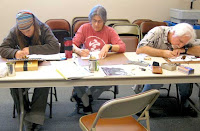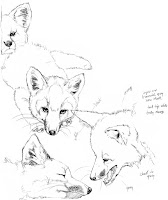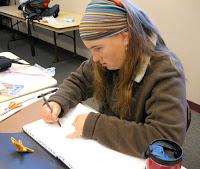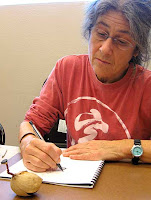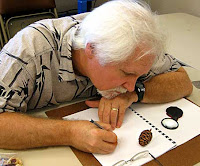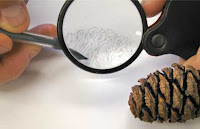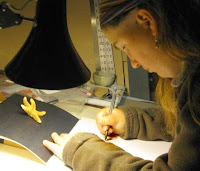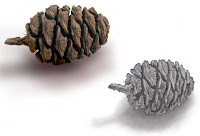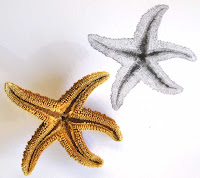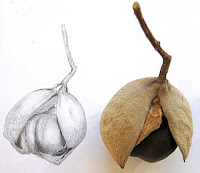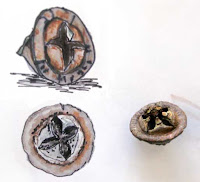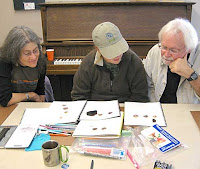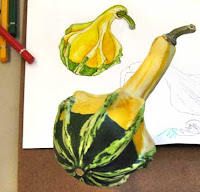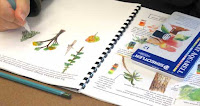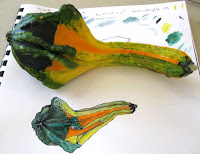 I'd hoped to blog the Wildlife Sketching Workshop before I held last weekend's Journaling workshop, but there's too much happening. F'rinstance, I'm sitting here at my computer damp and steamy from planting my little garden in a light misting drizzle. The poor little plants were getting wimpy sitting on the kitchen counter, and a rainy day is perfect to plant....so the blogging is just now beginning while I am trying to keep warm-though-moist.
I'd hoped to blog the Wildlife Sketching Workshop before I held last weekend's Journaling workshop, but there's too much happening. F'rinstance, I'm sitting here at my computer damp and steamy from planting my little garden in a light misting drizzle. The poor little plants were getting wimpy sitting on the kitchen counter, and a rainy day is perfect to plant....so the blogging is just now beginning while I am trying to keep warm-though-moist.On the other hand, hopefully, I have set out my cherry, grape and yellow tomatoes before they wilted ENTIRELY away, planted basil and cilantro, salad nasturtiums and a stevia (the "sweet" plant), and tried to get my sprinkler system going. Since it's raining, it's hard to tell if I got it right, though. It's a paltry garden this year. I have been too busy to poke my nose out the door (see last week's entry. And I'm working on a new project now, too.). That's the garden, big tree pots plunked down on my steep wooded hillside with a deer fence around it to keep out the wild turkeys and deer.
At any rate,

 about the Wildlife Sketching Basics workshop. I taught a similar class (Raptor Sketching) a couple of years ago for the Siskiyou Field Institute, and although the evaluations from the students were good, I wasn't satisfied. I didn't have time to teach them the basics of drawing properly before they were confronted by those imposing birds.
about the Wildlife Sketching Basics workshop. I taught a similar class (Raptor Sketching) a couple of years ago for the Siskiyou Field Institute, and although the evaluations from the students were good, I wasn't satisfied. I didn't have time to teach them the basics of drawing properly before they were confronted by those imposing birds.This time I had a full day to prepare them -- and it STILL wasn't enough. I'll show you how it went, then tell you how I think I'll fix it if SFI wants to try again next year.
On Day 1 I did a version of my basic drawing class, but
 with the sketching exercises oriented to things they might be sketching.
with the sketching exercises oriented to things they might be sketching.The first thing to do when sketching a living, moving thing is to study it quietly before beginning to sketch. I was actually very pleased with the way they were able to begin to see how to translate what they were viewing onto the paper.
 Here's one of the first exercises. They only had fifteen minutes to work on this, and they applied themselves to it vigorously. (And no, we didn't draw any frogs the second day!)
Here's one of the first exercises. They only had fifteen minutes to work on this, and they applied themselves to it vigorously. (And no, we didn't draw any frogs the second day!)Next, I showed them a number of textures which they would find useful for not only wildlife feathers and fur, but many other subjects as well.
One particular goal is to avoid a lot of erasing, which slows you down
 considerably, and also can frighten away your subject. So, believe it or not, I taught them to sketch with ballpoint pens. The fascinating thing about that is that after the first fright about working in ink, the students quickly become attracted to the way you can get tonal variety and quality from an ordinary ballpoint, and the fact that since you know you will be drawing without erasing, you observe much more carefully and accurately.
considerably, and also can frighten away your subject. So, believe it or not, I taught them to sketch with ballpoint pens. The fascinating thing about that is that after the first fright about working in ink, the students quickly become attracted to the way you can get tonal variety and quality from an ordinary ballpoint, and the fact that since you know you will be drawing without erasing, you observe much more carefully and accurately.Above is the texture exercise, which we did in both pencil and ballpoint with almost identical results. It was an epiphany for several of the students. I think
 I may have produced a couple more ballpoint converts with this class.
I may have produced a couple more ballpoint converts with this class.We quit at 2:30, all of us pretty worn out with the intense effort. This workshop was held at the Deer Creek Nature Center near Selma, Oregon, and although it was threatening to rain, I went for a walk along
 the creek to get some research photos for a trail signage project I'm working on for them. This is the Center, looking east. If you turn around toward the west, you see the huge old trees along the creek, and the mountain rising behind it. The side of that mountain is a tilted, boggy fen, covered with cobra lilies (Darlingtonia) which eat unwary insects. We sketched those in a workshop last September.
the creek to get some research photos for a trail signage project I'm working on for them. This is the Center, looking east. If you turn around toward the west, you see the huge old trees along the creek, and the mountain rising behind it. The side of that mountain is a tilted, boggy fen, covered with cobra lilies (Darlingtonia) which eat unwary insects. We sketched those in a workshop last September.I couldn't
 cross the
cross the  creek to see them since the water was pretty high, but the creek banks were beautiful, covered in mosses and populated by a gorgeous endemic plant found only a few places in the world. I forgot what I was told it is, but it grows in the water, standing more than two feet tall, and has
creek to see them since the water was pretty high, but the creek banks were beautiful, covered in mosses and populated by a gorgeous endemic plant found only a few places in the world. I forgot what I was told it is, but it grows in the water, standing more than two feet tall, and has candy pink pompoms of flowers at the top of thick, hairy stems. Any ideas?
candy pink pompoms of flowers at the top of thick, hairy stems. Any ideas?Across the hillside, in dry serpentine soil, Indian paintbrushes of orange, red, and nearly yellow, dotted the stony earth. This is a fascinating environment. But it started to rain, and it poured all night (much to my dismay, thinking of our wildlife sketching scheduled for the next day). The rain made quite a racket on the canvas roof of the Center's yurt, in which three of us were sleeping.
Day 2.
 With all that deluge, I didn't have high hopes for the next day, but when you're doing a workshop you have to take what comes, rain or shine. We had prepared as much as we could for the possibility of rain, and when we met at
With all that deluge, I didn't have high hopes for the next day, but when you're doing a workshop you have to take what comes, rain or shine. We had prepared as much as we could for the possibility of rain, and when we met at  Wildlife Images, Cyndee brought an owl, a bald eagle, and a Harlan's hawk (a variety of redtailed hawk) into the nice dry classroom for us to sketch for the morning. I think the students did remarkably well for a first try. Pat's sketch of the Harlan's hawk, here, is really nice.
Wildlife Images, Cyndee brought an owl, a bald eagle, and a Harlan's hawk (a variety of redtailed hawk) into the nice dry classroom for us to sketch for the morning. I think the students did remarkably well for a first try. Pat's sketch of the Harlan's hawk, here, is really nice.After our break for lunch, it wasn't raining
 so we went out to try to sketch cougar, bears and wolves. The grizzly bear fascinated us by clutching a sappy tree and gnawing on it (see the picture) but it all happened
so we went out to try to sketch cougar, bears and wolves. The grizzly bear fascinated us by clutching a sappy tree and gnawing on it (see the picture) but it all happened  too quickly to draw.
too quickly to draw.The students tried valiantly to sketch, but the animals were NOT pleased with the soggy day and weren't terribly cooperative. And I think the students were a bit overwhelmed, by then. Still, Richard turned out a nice cougar drawing, particularly considering that he had to look
 through heavy wire fence to see it.
through heavy wire fence to see it.At 2:30, getting sprinkled on and done in, the group headed back to the classroom for close-ups of Nubs the Badger.
 Nubs is a hoot, reminding me a bit of a furry, low-built tank. I got some quick sketches of him (see below), but without previous experience in sketching moving things, the students weren't able to catch much of this wiggly character.
Nubs is a hoot, reminding me a bit of a furry, low-built tank. I got some quick sketches of him (see below), but without previous experience in sketching moving things, the students weren't able to catch much of this wiggly character.  I encouraged the students to take lots of digital photos to work from later, so this turned out to be more a photo session than a sketching exercise.
I encouraged the students to take lots of digital photos to work from later, so this turned out to be more a photo session than a sketching exercise.So here's my thinking on this workshop. While the students gave the course a general thumbs-up, and did learn a lot about drawing, they also suggested that a half-day of wildlife sketching would be plenty. The brain wears out after so much input.
They
 also suggested that it might be helpful to spend the morning drawing from photos of the animals they would be sketching, just to get features and shapes firmly fixed in their minds and form mental templates of each animal. Then they could draw from the live animals in the afternoon. We had done a bit of hawk template drawing the previous day, but they would like even
also suggested that it might be helpful to spend the morning drawing from photos of the animals they would be sketching, just to get features and shapes firmly fixed in their minds and form mental templates of each animal. Then they could draw from the live animals in the afternoon. We had done a bit of hawk template drawing the previous day, but they would like even more.
more.I'm also thinking that we tried to cover too much ~ and that birds alone would be plenty to challenge the students. That would also mean that we wouldn't have to depend on good weather for the class since we draw the raptors in the classroom. We could hold that workshop any time of the year instead of having to wait for warm outdoor sketching weather. Excellent!
So next time, the class will be called "Raptor Sketching Basics," and I think everyone will be pleased as punch. Me too. I can hardly wait to try again.

